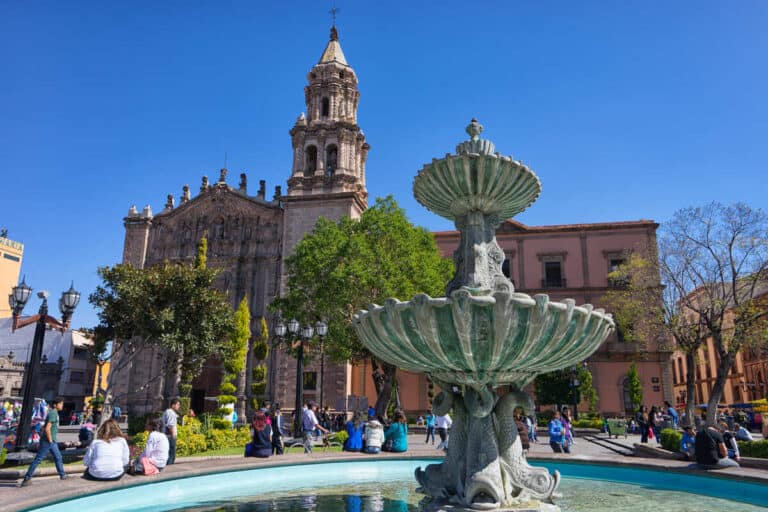Mexico is the first destination that comes to mind when Americans think of taking a cultural trip abroad.
It is close enough to home, the country as a whole is very tourist-friendly, and prices can be very attractive when you steer clear of overdeveloped coastal zones.
There is only one caveat: mainstream media does not paint a pretty picture of this incredibly historical country, often focusing on gang activity in suburban zones instead, in spite of the ongoing efforts on the part of local leaders to keep popular destinations crime-free.
As it turns out, a majority of cultural sites in Mexico are perfectly safe for visiting, in particular these four cities overly-conservative U.S. authorities themselves deem low-risk:
Aguascalientes
Aguascalientes is the capital and largest city of the state of the same name, founded as early as 1575 as a Catholic stronghold in the central Mexican plateau, a territory previously inhabited by nomadic Amerindians known as Chichimeca.
As a result, Aguascalientes boasts an impressive collection of Spanish-built landmarks, including a beautiful San Antonio de Padua Church, a Baroque Government Palace built out of local red volcanic stone, and numerous hot springs, in use since the colonial era.

Since its establishment, it’s been at the front of religious, industrial, and cultural revolutions in Mexico, playing a key role in its nation-building, especially after it hosted the Revolutionary Convention of 1914: for every Mexicophile, it’s a mandatory stopover on their History route.
Lucky for them, this inland spot is also one of the safest South of the border, having been added to the U.S. State Department’s Travel Advisory listings at Level 2. This means crime levels are only moderate, and U.S. visitors are not discouraged from visiting.

San Francisco de Campeche
Moving over to the Yucatan, San Francisco de Campeche has been largely ignored by visitors to the peninsula for decades now simply because it is worlds away from the glitz and glamor of the Mayan Coast, and it’s not your traditional all-inclusive tropical getaway.
That’s precisely why it is so special: it may be overshadowed by Cancun and the like, but it stands out with its preserved colonial core, dating back to the period of Spanish control, and impressive levels of safety across the municipality.

If it’s Old World charm you seek, you’ll be glad to know Campeche is one of only two settlements in the Americas, alongside Quebec City, to still have defensive walls. Furthermore, Baroque architecture dominates the cityscape, and churches are still in their original 16th-century form.
When it comes to safety, violent crime is exceedingly rare within the municipality, and even petty crime is not significant: Washington itself considers Campeche one of the safest cities in Mexico, awarding it a Level 1 status (the same category most European countries are found).

Merida
The other colonial jewel of Yucatan, Merida, was erected on holy Mayan grounds in the late 1500s, and it’s famous for having a high concentration of historic buildings arranged around an unusually large Old Town district, third in size in the Americas.
It is the product of the union of the Mayan and Spanish worlds, with many of the surviving stone structures in the colonial core having been built of dismantled Mayan temples. The most obvious example is the Cathedral of Merida, the oldest on the continent’s mainland.

Other modern-day manifestations of the forced intercultural marriage of Yucatanese cuisine, famous for combining Mayan and European elements and commonly found in Merida’s Gastronomic Corridor, and the city’s multi-ethnic character.
Besides being a melting pot of cultures, Merida is regularly considered Mexico’s safest major city and state capital, having been certified as an International Safe Community by a well-reputed Swedish institute in 2015 and enjoying a Level 1 status as awarded by the U.S. State Department.

San Luis Potosi
It’s easy to dismiss San Luis Potosi as a mere industrial hub in central Mexico, thanks to its thriving manufacturing industry, but we mustn’t forget this is one of the country’s most important cities in terms of cultural significance and accumulation of Hispanic heritage.
Much like the others already listed, its Old Town has a plethora of noteworthy architectural efforts, from the tile-adorned Temple of Our Lady of Carmen to the centuries-old Plaza de Armas, guarded by the imposing Governor’s Palace and a towering cathedral.

San Luis Potosi’s Downtown zone is nothing short of a treasure trove of colonial art. No wonder UNESCO has officially listed it as a World Heritage Site since 2010, forever marking it as an outstanding destination not only in Mexico, but globally.
The best thing is that the city is incredibly safe for foreign guests, featuring in the State Department’s advisories at Level 2: though some caution is urged when out in public, and avoiding wearing jewelry and flashing expensive items is advised, Americans are free to enjoy San Luis mostly hassle-free.

Whether it’s cobbled colonial towns cropped straight out of fairytale books or ancient Mayan ruins with origins lost to time that make their heart beat faster, Mexico’s historical trail is hundreds of miles long and dotted with hidden gems of the sort.
You may be spoiled for choice in picking your next cultural getaway south of the border, but you should know these four are undoubtedly good places to start.
Credit: Source link

